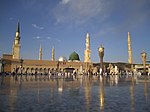The Seven Mosques
| The Seven Mosques | |
|---|---|
المساجد السبعة | |
 | |
| Religion | |
| Affiliation | Islam |
| Location | |
| Location | Medina, Saudi Arabia |
| Geographic coordinates | 24°28′36.6″N 39°35′45.5″E / 24.476833°N 39.595972°E |
| Architecture | |
| Type | Mosque |
The Seven Mosques (Arabic: المساجد السبعة, romanized: al-Masājid al-Saʿba) is a complex of six small historic and often visited mosques in the city of Medina, Saudi Arabia. The complex consists of six mosques in spite of the name "Sab'ah" means "seven", as the Saudi Government demolished one.[1][2]
History[edit]
The mosques here are linked to the Battle of the Trench (Ghazwat al-Khandaq), also known as the Battle of the Confederates (Ghazwat al-Ahzab). Muslims defending Medina were in these mosques and each mosque is named after the person who was stationed there.[3]
According to historians, there were originally only six mosques, however, a seventh mosque one kilometer away, Masjid al-Qiblatayn, was added as pilgrims would visit it during their pilgrimage.[3]
These mosques are located in south of Mount Sela which was the scene of the Battle of the Trench.[4]
Mosques in the complex[edit]
Al-Fath Mosque[edit]
This is the largest mosque of all, and it is located beneath of Mount Sala' on the western part. It is narrated that this mosque is named as "Al-Fath" due to the account of the prophet praying here during the Battle of the Trench, and the battle ended in Muslim victory (in Arabic, "Fath" or "Fatah" means "conquest" in Islamic context). The mosque was built during the time of the Caliph Umar bin Abdul Aziz, and renovated by the minister Saifuddin Abu al-Hija in 1154 during the time of the Sharifate of Mecca.
Salman Al-Farsi Mosque[edit]
Located 20 meters south of Al-Fath Mosque, named after Salman Al-Farsi who led the construction of trenches during the Battle of the Trench. The mosque is built during the time of Caliph Umar bin Abdul Aziz, and renovated by the minister Saifuddin Abu al-Hija in 1154 during the time of the Sharifate of Mecca.
Abu Bakr Al-Siddiq Mosque[edit]
It is located 15 meters southeast of Salman Al-Farsi Mosque. These three mosques (Al-Fath Mosque, Salman Al-Farsi Mosque and Abu Bakr As-Siddiq Mosque) were demolished and renovated into one mosque with wider space.
Umar bin Khattab Mosque[edit]
It is located 10 meters south of Abu Bakar As-Siddiq Mosque. This mosque is situated on higher altitude, and its look is corresponding to Al-Fath Mosque, thus it is considered that they were built and renovated at the same time.
Sa'd bin Mu'adh Mosque[edit]
Ali bin Abu Talib Mosque[edit]
Located in the south of Fathimah Az-Zahra Mosque on a small hill. This mosque has a length of 8.5 meters and width of 6.5 meters. It is narrated that Ali joined the Battle of the Trench here. Today, local government of Medina is renovating this mosque while maintaining the original shape, and building a large park surrounding it as a decoration of the small building.
Fatimah Az-Zahra Mosque[edit]
It is a small mosque attached to the others, with area of 4x3 meters. This mosque was built in the Ottoman period of the Hejaz Vilayet during the reign of Sultan Abdulmejid I.
See also[edit]
References[edit]
- ^ "Seven Mosques (al-Masajid as-Sab'a) - Madain Project (en)". madainproject.com. Retrieved 2024-04-03.
- ^ "What's the story of the Seven Mosques which pilgrims visit in Medina?".
- ^ a b "What's the story of the Seven Mosques which pilgrims visit in Medina?". Al Arabiya News.
- ^ Ahmed, Uzair (2022-08-23). "The Seven Mosques | Al-Masjid Al-Sab |". The Pilgrim. Retrieved 2024-04-22.



